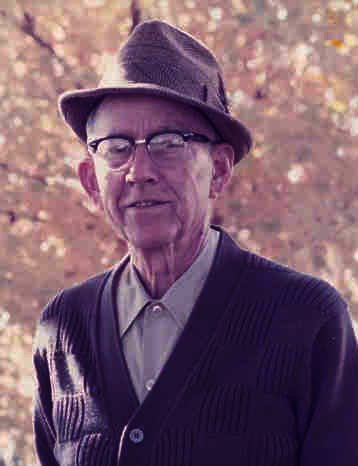
Biography of
John Edward "Ed" Schrock,
Photographer.
by
Janet (Schrock) Hubbard
John Edward ("Ed") Schrock captured life around him in photographs almost his entire life. Almost every facet of his life was tinged by his passionate interest in photography. The photos by him on this site represent only an insignificant portion of the thousands of photos he took over a period of nearly eighty years.
Born on May 28 1907 to Harve S. and Nettie Grace (Ray) Schrock while they were living in Dayton, New Mexico, he also lived in Texline, Texas as well as Greensburg and Meade, Kansas where his father managed lumberyards for his uncle, John Schrock.

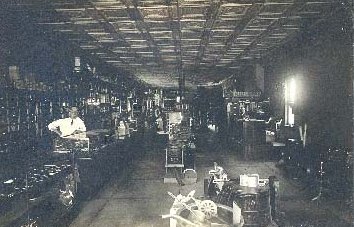 In 1911 the Schrocks moved to Wilmore in Comanche County, where once again Ed's father opened a lumberyard/hardware store, the Schrock Lumberyard. At left is a photo of Harve Schrock in his lumberyard.
In 1911 the Schrocks moved to Wilmore in Comanche County, where once again Ed's father opened a lumberyard/hardware store, the Schrock Lumberyard. At left is a photo of Harve Schrock in his lumberyard.
 Harve and Grace built their home in Wilmore soon after they arrived. Some of the earliest photos I have of them shows all three of them on the front porch.
Harve and Grace built their home in Wilmore soon after they arrived. Some of the earliest photos I have of them shows all three of them on the front porch.
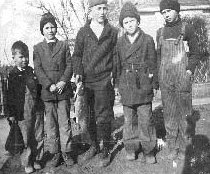 His childhood seems to have been an idyllic reflection of small-town life. He was an only child and was dearly loved. He loved to hunt and fish, and was apparently quite good at catching frogs so they could enjoy frog legs for dinner. He loved to tinker; he taught himself the Morse code and built a radio. He had a Little-Annie dog named Ned. Grace taught him at home until he was in the third grade. Perhaps that is why he was often somewhat shy and not terribly outgoing.
His childhood seems to have been an idyllic reflection of small-town life. He was an only child and was dearly loved. He loved to hunt and fish, and was apparently quite good at catching frogs so they could enjoy frog legs for dinner. He loved to tinker; he taught himself the Morse code and built a radio. He had a Little-Annie dog named Ned. Grace taught him at home until he was in the third grade. Perhaps that is why he was often somewhat shy and not terribly outgoing.
 When he was 11, the minister of their Baptist church introduced him to photography, teaching him to develop and print pictures. His first camera was an Eastman-Kodak No. 3 Brownie, which I still have. By the time he had reached high school he had opened his first portrait studio, actually just a little cook shack down the alley from their house. Grace helped him pose the children on top of an ice cream soda table. Because he usually wore knickers, he was called the "Knickerbocker Kid."
When he was 11, the minister of their Baptist church introduced him to photography, teaching him to develop and print pictures. His first camera was an Eastman-Kodak No. 3 Brownie, which I still have. By the time he had reached high school he had opened his first portrait studio, actually just a little cook shack down the alley from their house. Grace helped him pose the children on top of an ice cream soda table. Because he usually wore knickers, he was called the "Knickerbocker Kid."
The population of Wilmore was much larger then than it is now (as many as seven hundred at one time), but he was still one of only a few in his school class. Once he started taking pictures, the number of photos of him decreased greatly, but he is always easy to recognize because of his slender face and prominent ears. Always slightly spoiled by his parents, he dressed well. He was tall and slender. He was on the high school basketball team. He was apparently an avid tennis player and sometimes a golfer too. However, their Mennonite/Baptist upbringing never permitted dancing, although they had a lovely phonograph. He had a prominent part in the high school play, but I can imagine that was because there were not a lot of candidates. He was often self conscious. He sometimes had a short temper. He was a gentleman. Scrupulously honest.
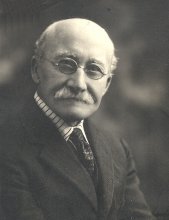 By the time he graduated from high school, he had taken two memorable portraits: one of his paternal grandmother, Margaret Stauffer Schrock, and one of his maternal grandfather, Joseph Worth Ray, seen at left. And he'd started taking local wedding photos too. I've heard from at least one local girl who confessed to having a serious crush on him.
By the time he graduated from high school, he had taken two memorable portraits: one of his paternal grandmother, Margaret Stauffer Schrock, and one of his maternal grandfather, Joseph Worth Ray, seen at left. And he'd started taking local wedding photos too. I've heard from at least one local girl who confessed to having a serious crush on him.
Harve had lost his share of the lumberyard in the early 20's after terrible droughts during WWI and afterward made it difficult for local townspeople to pay for the lumber they had bought from him to build their houses, because everyone lost their crops each year. Rather than take families to court, Harve absorbed their debts personally and eventually the lumberyard had to be sold. Reluctantly he turned to farming, and he too was faced with years of drought and hardship. The roaring twenties were not good for Wilmore.
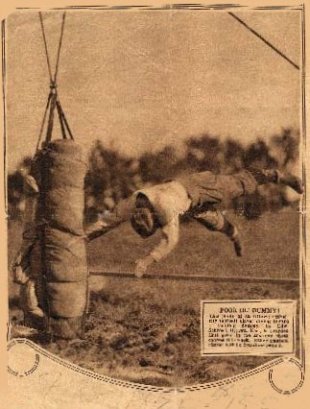 After Ed graduated from Wilmore's high school, he went off to Ottawa's Baptist University for two years. He must have had a wonderful time at Ottawa, for he took photos of picnics and girls wading in the creek as well as several of his favorite professors and a couple of girlfriends. His dynamic photo of a tackling football player won the first prize in a local photo contest and netted him $15.
After Ed graduated from Wilmore's high school, he went off to Ottawa's Baptist University for two years. He must have had a wonderful time at Ottawa, for he took photos of picnics and girls wading in the creek as well as several of his favorite professors and a couple of girlfriends. His dynamic photo of a tackling football player won the first prize in a local photo contest and netted him $15.
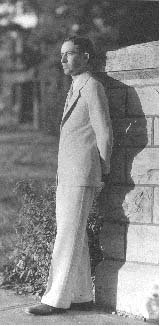 In 1926 he transferred to Kansas State College to study electrical engineering. While he was there one of his friends introduced him to my mother, Lyla Roepke. Two years younger than he, she was majoring in home economics. Although he had dated many girls at Ottawa, he and Lyla didn't date anyone else after they met.
In 1926 he transferred to Kansas State College to study electrical engineering. While he was there one of his friends introduced him to my mother, Lyla Roepke. Two years younger than he, she was majoring in home economics. Although he had dated many girls at Ottawa, he and Lyla didn't date anyone else after they met.
Lyla was one of nine children and she attended college on alternate years so she could work for her tuition money. My father, on the other hand, didn't seem to have worked during college. Of course we have since learned that Harve paid a heavy price to earn Edward's college tuition money. Sometime during the 20's, Harve made
bootleg whiskey and sold it in order to finance Ed's college education. Ultimately Harve was arrested and jailed for the offence. (Unfortunately we didn't learn of this while my father could tell us about this and those few people who are still alive who know about it personally refuse to discuss it.)
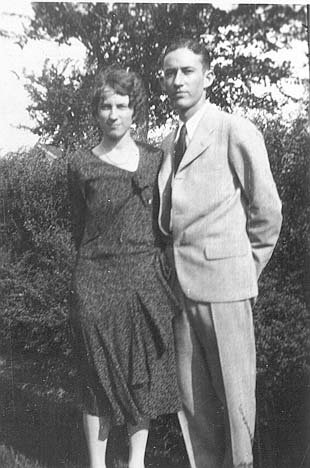
Ed wired Harve and Grace's house while he was in college, making it the first house in Wilmore to have electricity. Sometime during this period he took some glass negatives with a large viewfinder camera.
After he graduated from K-State in 1928 he went to work for General Electric, first in Schenectady, New York and then in Erie, Pennsylvania before losing his job after the depression started because he had no seniority. Then he worked briefly for Union Electric Co. in St. Louis. He suffered a leg injury while there and returned home to recuperate.
By then the depression had worsened and he did not return to his job in St Louis. He was lucky to hear of an opening in the County Road department for an Assistant County Engineer; eventually his boss retired and he became the County Engineer. He never again worked professionally as an electrical engineer.
Harve and Grace were facing very hard times. They were about to lose their farm outside Wilmore due to back taxes owed of less than $100. Edward's income enabled him to pay their taxes for them. And he returned for many years to help with the harvesting (until his back surgery later).
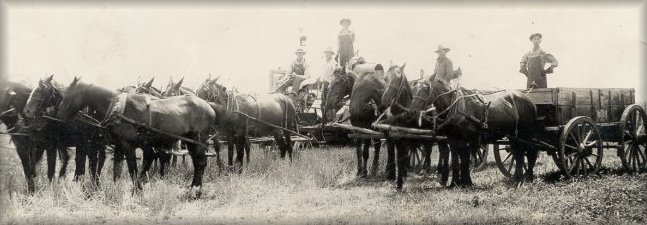 Photo by
John Edward ("Ed") Schrock & an assistant. Ed Schrock is the man standing in the wagon at right in the above photo.
Photo by
John Edward ("Ed") Schrock & an assistant. Ed Schrock is the man standing in the wagon at right in the above photo.
Lyla, meantime, graduated from K-State with a major in Home Economics. She taught high school home economics and worked for the Dean of K-State's Home Economics Department until they were married on September 1, 1934 in Wichita, Kansas. Lyla was unable to continue teaching, for the rules then idiotically prohibited women from teaching after they were married. They rented a house in Coldwater, and joined the Baptist church. Ed became good friends with Ward Butcher, the editor of the Western Star.
 And when I was born in Wichita in 1939, Grace flew with Ward Butcher in his airplane to visit me.
After my birth, Ed had a captive model. He posed me in the high chair getting my first permanent. He gave me a tube of shaving cream and had me brush my teeth for the first time by myself. He took pictures of me in my undershirt, peering into dresser drawers, playing dress-up, and sitting on Harve's cows. One of my favorite photos shows me watching Harve crank the ice cream freezer on the backporch while Grace peers out the screen door and their longtime friend, Buford Davis, smokes his cigar nearby.
And when I was born in Wichita in 1939, Grace flew with Ward Butcher in his airplane to visit me.
After my birth, Ed had a captive model. He posed me in the high chair getting my first permanent. He gave me a tube of shaving cream and had me brush my teeth for the first time by myself. He took pictures of me in my undershirt, peering into dresser drawers, playing dress-up, and sitting on Harve's cows. One of my favorite photos shows me watching Harve crank the ice cream freezer on the backporch while Grace peers out the screen door and their longtime friend, Buford Davis, smokes his cigar nearby.
Sometime during this period he seems to have also started documenting living room scenes. He captured Bertha and Tom Pepperd at home by the fireplace, Mrs. Ferrin with her cat by the fire, and Lyla knitting. And our neighbors, the Burtons, at Christmas.
He must have flown with Ward Butcher to take some of the aerial photos of Wilmore, Coldwater, and Protection that we have. He was using a Speed Graflex by then, and taking movies as well as 35 mm slides.
Grace, his mother, was an ardent gardener who raised both flowers and vegetables. She supplied the church with flowers and the whole town with food. Grace and her flowers as well as her sewing club were also well documented throughout the years. As were local groups and events. Even the Wilmore cemetery.
In 1941 he went to work for the State Water Resources Department. We lived in a series of little towns including Emporia before moving to Topeka in 1943. While he was out surveying as part of his job in 1944, he injured a disc in his back and eventually he had to have back surgery. From then on, his back was never the same and he often had to wear a corseted back brace. Instead of tennis, he took up canoeing and fishing.
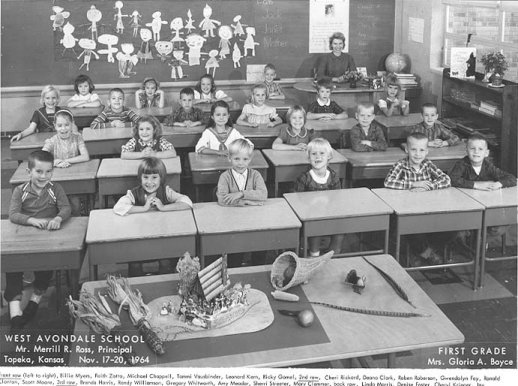 When I was in the first grade (1946), he asked the principal of my grade school, Randolph School in Topeka, permission to take a photograph of our class sitting in our seats. He was never happy with the typical individual portraits that were so commonly taken by commercial companies of students. That first year he took only my class and sold copies for a nominal price. They were so popular that the next year he took photographs of each class. He took two shots of each class. Within a few years he was using all of his vacation time to take pictures in several grade schools in Topeka. Except for our infrequent trips to Wilmore, we never again had a vacation once he started taking school pictures.
When I was in the first grade (1946), he asked the principal of my grade school, Randolph School in Topeka, permission to take a photograph of our class sitting in our seats. He was never happy with the typical individual portraits that were so commonly taken by commercial companies of students. That first year he took only my class and sold copies for a nominal price. They were so popular that the next year he took photographs of each class. He took two shots of each class. Within a few years he was using all of his vacation time to take pictures in several grade schools in Topeka. Except for our infrequent trips to Wilmore, we never again had a vacation once he started taking school pictures.
He was known all over Topeka. He was called "the picture man." In order to make sure that the kids were not frightened by the lights and camera, he gave them names, such as PeeWee and CopyCat.
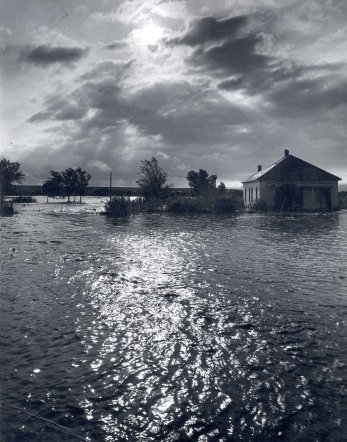 Live was hectic. His days were long. He worked all day at his State Water Resources job, where for many years he traveled around the state measuring the water to help farmers establish their water rights. No air conditioning. No state cars. And he documented much of this with photos as well. He also was asked to document state meetings and conventions.
At night he developed the negatives and printed samples and the photos that were ordered. Mother was responsible for preparing the samples, delivering them to the schools, picking up the orders, helping him with the developing and drying, sorting and stamping and packing. On a typical night, he would go to bed by about 8 or 8:30, then they would get up about midnight or so and print until about 4, then go to bed to sleep for a few hours before getting up at 6 to eat breakfast and go to work. And years later when he could easily have slept late, he would be up and dressed by 5 or 6.
Live was hectic. His days were long. He worked all day at his State Water Resources job, where for many years he traveled around the state measuring the water to help farmers establish their water rights. No air conditioning. No state cars. And he documented much of this with photos as well. He also was asked to document state meetings and conventions.
At night he developed the negatives and printed samples and the photos that were ordered. Mother was responsible for preparing the samples, delivering them to the schools, picking up the orders, helping him with the developing and drying, sorting and stamping and packing. On a typical night, he would go to bed by about 8 or 8:30, then they would get up about midnight or so and print until about 4, then go to bed to sleep for a few hours before getting up at 6 to eat breakfast and go to work. And years later when he could easily have slept late, he would be up and dressed by 5 or 6.
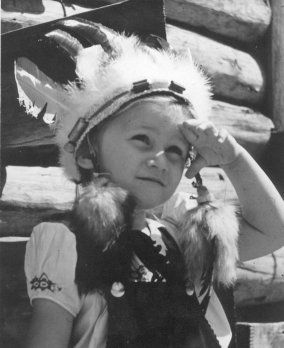 During his spare time, he continued to pose me in a variety of staged shots, as well to document our everyday life. He became very active in the Topeka Camera Club and won awards for at least one of his photos. He also entered a weekly photo contest sponsored by the local newspaper, the Topeka Daily Capital/Journal. I grew to hate posing. It seemed to take forever, sitting under the hot floodlights. My best pictures were when I was younger and a more willing model.
During his spare time, he continued to pose me in a variety of staged shots, as well to document our everyday life. He became very active in the Topeka Camera Club and won awards for at least one of his photos. He also entered a weekly photo contest sponsored by the local newspaper, the Topeka Daily Capital/Journal. I grew to hate posing. It seemed to take forever, sitting under the hot floodlights. My best pictures were when I was younger and a more willing model.
I believe I still have all but a couple of the cameras he owned during his lifetime. He used a Deardorff to take the school photos. He always insisted on mixing his own chemical for processing, keeping careful records of his own formulas. He had at the time of his death three enlargers; I still have the Durst enlarger. He bought film in bulk and loaded it into the negative carriers. And I believe I have every negative he ever took, starting with the glass negatives all the way to the last of the school and vacation photos. Plus boxes and boxes of movies and slides.
I can still remember how much fun it was to print pictures with him. He had a variety of little wire paddles with pieces of round cardboard taped to them. He would use these to "dodge" the pictures as they were being printed onto the paper, blocking light. He always said that half of the picture quality was done in the darkroom. Of course, I thought then that everyone knew how to do this like he did. Now I'm not so sure.
Once the picture was enlarged from the negative, it would go first into the developer, then the hypo, then the fixative. Was there a short stop also? I probably have the sequence wrong. But in the first tray the picture would magically appear. You'd take the tongs and swish it around. And when it got dark enough, move it quickly into the short stop to stop it from changing further, and then the fixative to fix it forever. Then into a tray of water until it was time to dry it.
Initially we used to dry the pictures by turning them upside down on sheets of newspaper. Mother and I would lay them out, then pick them up. By the dozens. Eventually we got a big electric drum dryer. It was my job to help Mother put them on and take them off. And I used to get 50 cents for printing the names of the students with a special ink-filled pen. He taught me all about kerning although I didn't know what it was called until years later.
When I was in the eighth grade we moved from our rented furnished duplex to our own house on what was then the outskirts of Topeka. Now he had room for a larger darkroom and finishing space for the drying, etc. As the school photos consumed more of his time, he took fewer freelance portraits. He took the cover pictures for one of the Kansas Water publications. He seems to have been free reign to pick his subjects. My cousin, Stephen Roepke, along with our dachshound Fritzi starred in one which was titled "The Low Down."
Eventually landscapes seem to have replaced his interest in portraits. When he retired from the State, he and Lyla took some long cross country trips. He moved from canoeing and fishing at Lake Shawnee in Topeka to fishing in the Rio Grande River and some of the national parks. Then he took a class in portraits from a famous photographer and bought the Durst enlarger . But he never was as active as he had been earlier. He continued to read the photo magazines and keep up, but he never tried using a computer or knew about the digital photographic world.
A few years after his retirement, he was diagnosed with colon cancer. The surgery seemed to be successful but eventually his health declined. He and Lyla traveled, pulling their Airstream trailer, camped and fished. He took fewer and fewer photos except of family and family reunions.
In 1961 Harve had died in a nursing home in Cunningham, Kansas after a long terrible bout with prostate cancer. Grace lived by herself in Wilmore until she fell in the late 1970's and broke her femur. She never returned to Wilmore to live after that. After living in the Protection Manor in Protection, Kansas for several years, she died in Topeka in 1980.
Ed still dreamed of returning to live in Wilmore one day, and for years he and Lyla returned to Wilmore for visits. By the early 1990's Ed was finding it harder and harder to walk unassisted. He had trouble thinking clearly sometimes. He fell frequently and by Christmas of 1993 he probably had suffered a small stroke. He died at a nursing home in Topeka on May 19, 1994, about a half an hour before Jackie Kennedy died. I like to think of him taking her picture when she got to heaven. His autopsy shows that he died from colon cancer but also suffered from an inoperable blockage of the carotid artery near the brain.
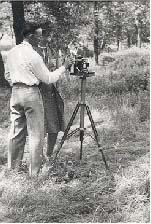 I remember how we always made fun of him when we were waiting for him to take pictures while we were traveling. Once when we went on the Seventeen Mile Drive in Carmel with them, the rest of us left him there beside the road and went on into Carmel for a while. When we returned a couple of hours later he was just finishing up.
I remember how we always made fun of him when we were waiting for him to take pictures while we were traveling. Once when we went on the Seventeen Mile Drive in Carmel with them, the rest of us left him there beside the road and went on into Carmel for a while. When we returned a couple of hours later he was just finishing up.
But while other fathers took quick snapshots or went to ballgames, mine was busy documenting my life and those of those I loved. What seemed like a burden at times is now a blessing.
History and those who know photography better than I will judge how good he was at it. I am too prejudiced to try. I regret not paying more attention to his techniques. My role is now to use what he did for the maximum benefit of us all. I have now assumed the role of the family photographer and it will never bother me to be teased about it.
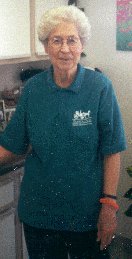 Lyla, my mother, is still well and now documents her own life. When she wrote recently of the romances in her retirement home, she said, "You don't need to worry about me doing that. I had a good one and that was for life. He was a neat one, shaved every day and took good care of me. Never had to pick up his clothes for he liked order and so did I. One can't judge a person when they fall ill for that can make a change."
Lyla, my mother, is still well and now documents her own life. When she wrote recently of the romances in her retirement home, she said, "You don't need to worry about me doing that. I had a good one and that was for life. He was a neat one, shaved every day and took good care of me. Never had to pick up his clothes for he liked order and so did I. One can't judge a person when they fall ill for that can make a change."
Now that my father is gone I feel I understand him in a way I couldn't seem to while he was alive. He was a difficult person to be with at times, especially as his brain got less oxygen towards the end. While he was in the nursing home, sitting endlessly for hours staring ahead, I asked him if the time passed quickly or not. I wasn't sure he even heard me for a while. Then he answered sadly and wistfully, "Slowly. Oh, so slow." I hope that time is once again flying by for him and that he has his choice of willing subjects. --
Janet (Schrock) Hubbard
Lyla (Roepke) Schrock
The Western Star, May 26, 1994.
John Edward Schrock
John Edward Schrock, 86, died May 19, 1994 at a Topeka nursing home. He worked for the Kansas State Board of Agriculture, in the Division of Water Resources for 30 years, retiring in 1971 as Water Commissioner of the Topeka Field Office.
He was born May 28, 1907, at Dayton, N. M., the son of Harvey S. and Nettie Grace (Ray) Schrock. He also lived in Texline, Tex., and Greensburg and Meade, before moving to Wilmore in 1911, where his father managed a lumberyard.
He graduated from Wilmore High School and then attended Ottawa University one and one half years before transferring to Kansas State, where he graduated in 1928 with a degree in electrical engineering.
Following graduation he worked for General Electric Co. in Schenectady, N. Y. and Erie, Pa., until the depression, then for Union Electric Co. in St. Louis.
His lifetime interest in photography began at age 11 when a Wilmore minister who had been a professional photographer taught him to develop and print pictures.
While in high school he owned and operated his studio made from a cook shack and took pictures of local children and groups.
Because he wore knickerbockers he was called the "knickerbocker photographer."
Much later in life Topeka school children called him "the picture man" when he took their grade school pictures.
He married Lyla S. Roepke of Manhattan, kans., on Sept. 1, 1934. They made their home in Coldwater where he was employed by Comanche County first as Assistant and later as County Engineer until 1941.
Survivors include his wife, a daughter, Janet Hubbard, The Sea Ranch, Calif., and grandson, Greg Hubbard of New York City.
Funeral services were May 24, 1994 at Highland Park Baptist Church. Cremation followed.
Memorial contributions may be made to Highland Park Southern Baptist Church, 820 East 29th St., Topeka, Kans. 66605.
Also see:
Tornados in the Wilmore, Kansas area
A story about the tornado which hit Wilmore on May 20th, 1949, written by Wendel Ferrin and illustrated with photos by John Edward Schrock.
The Wilmore News, May 27, 1949: "Twister Wrecks Wilmore Business District"
The Wilmore News, June 3, 1949: "Town Cleaning Up After Tornado Damage"
The Wilmore News, September 9, 1949: "MULE CREEK AGAIN FLOODS IN NORTH PART OF WILMORE"
Many of the obituary pages for people buried in the Wilmore/Powell Township Cemetery are illustrated with photos of their gravestones which were taken by John Edward Schrock. Those photos were once on the Wilmore Cemetery page, but have been moved to the individual obituary pages so that the Wilmore Cemetery page will load faster for site viewers.
This website is being created by Jerry Ferrin with the encouragement and assistance of Janet (Schrock) Hubbard. Both of us have roots in the county. In fact,
her grandmother lived next door to my great-grandmother in Wilmore, Kansas.
Janet and I met through postings at RootsWeb. It was a real stroke of fortune for me, as I'd known of her father and had seen many of his photos of my Ferrin ancestors & relatives which had been taken by him. I'd even made written queries to local people in order to find him so that I could ask if he had any more photos of my family; I heard, as I recall, that he lived in Topeka, Kansas, but I never did find his phone number and give him a call.
However, within a few months of having discovered RootsWeb, I was suddenly in touch with Ed's daughter, who sent me a wonderful story she'd written about my great-grandmother, and who has been very generous in sharing her father's photos with me, and through this website, with the world. All of John Edward Schrock's photographs are copyrighted; please contact
Janet (Schrock) Hubbard
if you'd like to request permission to copy or republish any of this photographs.
The Harvey and Grace Schrock house in Wilmore is owned and occupied today, 20 August 2006, by my first cousin, Dan E. Ferrin, and his family. The last time I visited Dan, in November of 2004, he showed me the small room, in what is today Dan's garage, which was once John Edward Schrock's darkroom. Photographic formulas are still visible on the unpainted wooden walls of that small room where Ed Schrock wrote them with a lead graphite pencil.
For a history of that lot in Wilmore once owned by Harve Schrock, see Abstract of Title to Lots in Wilmore, Kansas, which Janet (Schrock) Hubbard also provided for this web site.
Thanks to Shirley Brier for finding, transcribing and contributing the above obituary for John E. Schrock to this web site!
This RootsWeb website is being created by Jerry Ferrin with the able assistance of Janet (Schrock) Hubbard and many other Contributors. Your comments, suggestions and contributions of historical information and photographs to this site are welcome. Please sign the Guest Book. This page was updated 25 Nov 2003 and 23 September 2006.


 In 1911 the Schrocks moved to Wilmore in Comanche County, where once again Ed's father opened a lumberyard/hardware store, the Schrock Lumberyard. At left is a photo of Harve Schrock in his lumberyard.
In 1911 the Schrocks moved to Wilmore in Comanche County, where once again Ed's father opened a lumberyard/hardware store, the Schrock Lumberyard. At left is a photo of Harve Schrock in his lumberyard. Harve and Grace built their home in Wilmore soon after they arrived. Some of the earliest photos I have of them shows all three of them on the front porch.
Harve and Grace built their home in Wilmore soon after they arrived. Some of the earliest photos I have of them shows all three of them on the front porch.  His childhood seems to have been an idyllic reflection of small-town life. He was an only child and was dearly loved. He loved to hunt and fish, and was apparently quite good at catching frogs so they could enjoy frog legs for dinner. He loved to tinker; he taught himself the Morse code and built a radio. He had a Little-Annie dog named Ned. Grace taught him at home until he was in the third grade. Perhaps that is why he was often somewhat shy and not terribly outgoing.
His childhood seems to have been an idyllic reflection of small-town life. He was an only child and was dearly loved. He loved to hunt and fish, and was apparently quite good at catching frogs so they could enjoy frog legs for dinner. He loved to tinker; he taught himself the Morse code and built a radio. He had a Little-Annie dog named Ned. Grace taught him at home until he was in the third grade. Perhaps that is why he was often somewhat shy and not terribly outgoing.
 When he was 11, the minister of their Baptist church introduced him to photography, teaching him to develop and print pictures. His first camera was an Eastman-Kodak No. 3 Brownie, which I still have. By the time he had reached high school he had opened his first portrait studio, actually just a little cook shack down the alley from their house. Grace helped him pose the children on top of an ice cream soda table. Because he usually wore knickers, he was called the "Knickerbocker Kid."
When he was 11, the minister of their Baptist church introduced him to photography, teaching him to develop and print pictures. His first camera was an Eastman-Kodak No. 3 Brownie, which I still have. By the time he had reached high school he had opened his first portrait studio, actually just a little cook shack down the alley from their house. Grace helped him pose the children on top of an ice cream soda table. Because he usually wore knickers, he was called the "Knickerbocker Kid." By the time he graduated from high school, he had taken two memorable portraits: one of his paternal grandmother, Margaret Stauffer Schrock, and one of his maternal grandfather, Joseph Worth Ray, seen at left. And he'd started taking local wedding photos too. I've heard from at least one local girl who confessed to having a serious crush on him.
By the time he graduated from high school, he had taken two memorable portraits: one of his paternal grandmother, Margaret Stauffer Schrock, and one of his maternal grandfather, Joseph Worth Ray, seen at left. And he'd started taking local wedding photos too. I've heard from at least one local girl who confessed to having a serious crush on him. After Ed graduated from Wilmore's high school, he went off to Ottawa's Baptist University for two years. He must have had a wonderful time at Ottawa, for he took photos of picnics and girls wading in the creek as well as several of his favorite professors and a couple of girlfriends. His dynamic photo of a tackling football player won the first prize in a local photo contest and netted him $15.
After Ed graduated from Wilmore's high school, he went off to Ottawa's Baptist University for two years. He must have had a wonderful time at Ottawa, for he took photos of picnics and girls wading in the creek as well as several of his favorite professors and a couple of girlfriends. His dynamic photo of a tackling football player won the first prize in a local photo contest and netted him $15. In 1926 he transferred to Kansas State College to study electrical engineering. While he was there one of his friends introduced him to my mother, Lyla Roepke. Two years younger than he, she was majoring in home economics. Although he had dated many girls at Ottawa, he and Lyla didn't date anyone else after they met.
In 1926 he transferred to Kansas State College to study electrical engineering. While he was there one of his friends introduced him to my mother, Lyla Roepke. Two years younger than he, she was majoring in home economics. Although he had dated many girls at Ottawa, he and Lyla didn't date anyone else after they met. 
 Photo by
John Edward ("Ed") Schrock & an assistant. Ed Schrock is the man standing in the wagon at right in the above photo.
Photo by
John Edward ("Ed") Schrock & an assistant. Ed Schrock is the man standing in the wagon at right in the above photo.  And when I was born in Wichita in 1939, Grace flew with Ward Butcher in his airplane to visit me.
After my birth, Ed had a captive model. He posed me in the high chair getting my first permanent. He gave me a tube of shaving cream and had me brush my teeth for the first time by myself. He took pictures of me in my undershirt, peering into dresser drawers, playing dress-up, and sitting on Harve's cows. One of my favorite photos shows me watching Harve crank the ice cream freezer on the backporch while Grace peers out the screen door and their longtime friend, Buford Davis, smokes his cigar nearby.
And when I was born in Wichita in 1939, Grace flew with Ward Butcher in his airplane to visit me.
After my birth, Ed had a captive model. He posed me in the high chair getting my first permanent. He gave me a tube of shaving cream and had me brush my teeth for the first time by myself. He took pictures of me in my undershirt, peering into dresser drawers, playing dress-up, and sitting on Harve's cows. One of my favorite photos shows me watching Harve crank the ice cream freezer on the backporch while Grace peers out the screen door and their longtime friend, Buford Davis, smokes his cigar nearby.

 When I was in the first grade (1946), he asked the principal of my grade school, Randolph School in Topeka, permission to take a photograph of our class sitting in our seats. He was never happy with the typical individual portraits that were so commonly taken by commercial companies of students. That first year he took only my class and sold copies for a nominal price. They were so popular that the next year he took photographs of each class. He took two shots of each class. Within a few years he was using all of his vacation time to take pictures in several grade schools in Topeka. Except for our infrequent trips to Wilmore, we never again had a vacation once he started taking school pictures.
When I was in the first grade (1946), he asked the principal of my grade school, Randolph School in Topeka, permission to take a photograph of our class sitting in our seats. He was never happy with the typical individual portraits that were so commonly taken by commercial companies of students. That first year he took only my class and sold copies for a nominal price. They were so popular that the next year he took photographs of each class. He took two shots of each class. Within a few years he was using all of his vacation time to take pictures in several grade schools in Topeka. Except for our infrequent trips to Wilmore, we never again had a vacation once he started taking school pictures.

 During his spare time, he continued to pose me in a variety of staged shots, as well to document our everyday life. He became very active in the Topeka Camera Club and won awards for at least one of his photos. He also entered a weekly photo contest sponsored by the local newspaper, the Topeka Daily Capital/Journal. I grew to hate posing. It seemed to take forever, sitting under the hot floodlights. My best pictures were when I was younger and a more willing model.
During his spare time, he continued to pose me in a variety of staged shots, as well to document our everyday life. He became very active in the Topeka Camera Club and won awards for at least one of his photos. He also entered a weekly photo contest sponsored by the local newspaper, the Topeka Daily Capital/Journal. I grew to hate posing. It seemed to take forever, sitting under the hot floodlights. My best pictures were when I was younger and a more willing model. I remember how we always made fun of him when we were waiting for him to take pictures while we were traveling. Once when we went on the Seventeen Mile Drive in Carmel with them, the rest of us left him there beside the road and went on into Carmel for a while. When we returned a couple of hours later he was just finishing up.
I remember how we always made fun of him when we were waiting for him to take pictures while we were traveling. Once when we went on the Seventeen Mile Drive in Carmel with them, the rest of us left him there beside the road and went on into Carmel for a while. When we returned a couple of hours later he was just finishing up. Lyla, my mother, is still well and now documents her own life. When she wrote recently of the romances in her retirement home, she said, "You don't need to worry about me doing that. I had a good one and that was for life. He was a neat one, shaved every day and took good care of me. Never had to pick up his clothes for he liked order and so did I. One can't judge a person when they fall ill for that can make a change."
Lyla, my mother, is still well and now documents her own life. When she wrote recently of the romances in her retirement home, she said, "You don't need to worry about me doing that. I had a good one and that was for life. He was a neat one, shaved every day and took good care of me. Never had to pick up his clothes for he liked order and so did I. One can't judge a person when they fall ill for that can make a change."